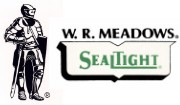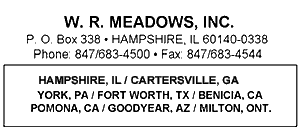| |

NO. 231-PD
SEALTIGHT®
DIRECT FIRE
PARKING LOT SEALANT (PLS)
Technical Description
SEALTIGHT Direct Fire Parking Lot Sealant
(PLS)is formulated specifically for melting and heating in direct fire kettles.
It is a single-component,hot-applied, self-leveling sealant to be used for
sealing joints and cracks in Portland Cement or asphaltic concrete pavements.PLS
is easily melted and applied, and will form a flexible, resilient, non-tracking
seal suitable for use on both highways and parking lots.
PHYSICAL PROPERTIES
| Test |
|
Typical
Result |
Recommended
Specification |
| Penetration,77 °F |
|
50 |
15-75 |
| Resilience,%: |
|
55% |
40%(min.) |
| Softening
point,°F: |
|
210
°F |
200
°F (min.) |
| Flexibility,90
°bend 1"mandrel @0 °F: |
|
Pass |
Pass |
| Viscosity
@400°F: |
500
cps |
|
|
| Weight/Gallon: |
8.8
lbs./gal |
|
|
Recommended
Pouring
Temperature: |
400
°F |
|
|
Maximum Safe
Heating
Temperature: |
450
°F |
|
|
Packaging
50 lb.cartons containing two (2)25-pound blocks individually wrapped in poly bag
liners.
Precautions
PLS can be reheated several times. The
material will not gel when overheated or heated for extended periods.
Temperatures above 400°F for extended periods (over 6 hours) will begin to
soften the material. If heated above 450°F, the material will begin to degrade
and lose its flexibility.
Surface Preparation
The joints and cracks to be sealed must be clean and dry. The cleaning operation
can be performed using a router, wire brush, oil-free compressed air, sand
blaster, heat lance or other acceptable method. Curing compounds on interfaces
must be removed by sandblasting. Dust, dirt and laitance should be blown out of
the joint with oil-free compressed air immediately preceding the sealing
operation. Sidewalls must be stable and intact. Air and pavement temperatures
should be above freezing at time of sealant application.
Concrete or asphaltic Pavement and Maintenance
Sealing - For ideal sealing with maximum
effectiveness, it is suggested that cracks or joints should be routed out to
provide a sealant reservoir 1/2" (12.7mm) wide with a minimum depth of
1/2" (12.7mm). This provides for a 1:1 width-to-depth ratio. For joints
1" (25.4mm) wide, the suggested depth is 1/2" (12.7mm) minimum.
Proper routing should be slightly larger than existing
crack/joint to ensure proper adhesion to sidewalls.
The sealant should be applied into the crack/joint from bottom up, slightly
overfilling. Once applied, a follow-up should be done with a soft, rubber,
U-shaped squeegee to form a wipe zone of approximately 3-4 inches (76.2-101.6mm)
wide along the crack/joint and flush with the highway or pavement surface. To
control and maintain the suggested joint depth and sealant usage, SEALTIGHT CERA-ROD
Heat-Resistant Backer Rod may be installed in the joint opening.
USE AND APPLICATION
 | Material can be melted in either a direct fire or oil
jacketed kettle. Kettles should be equipped with an agitator and properly
functioning temperature gauges. Material can be applied by pressure
applicator or pour pot.
 | The polymers contained in PLS can withstand
temperatures up to 450 °F. After melting, the material should be agitated
mechanically. Material may be added as the sealant is drawn off. The product
is capable of being reheated several times and will not gel when overheated
or heated for extended periods.
 | Material should be applied between 350 °F and 450 °F.
The recommended application temperature is 400 °F.
 | The crackfiller should be tack free prior to coating
with a blacktop sealer. |
| | |


LIMITED WARRANTY
W.R.MEADOWS,INC. warrants that at the time and place we make shipment, our
material will be of good quality and will conform with our published
specifications in force on the date of acceptance of the order. Read complete
warranty. Copy furnished upon request.
Disclaimer
The information contained herein is included for illustrative purposes only, and
to the best of our knowledge, is accurate and reliable. W.R.MEADOWS,INC. cannot
however under any circumstances make any guarantee of results or assume any
obligation or liability in connection with the use of this information. As
W.R.MEADOWS, INC. has no control over the use to which others may put its
product, it is recommended that the products be tested to determine if suitable
for specific application and/or our information is valid in a particular
circumstance. Responsibility remains with the architect or engineer, contractor
and owner for the design, application and proper installation of each product.
Specifier and user shall determine the suitability of
products for specific application and assume all responsibilities in connection
therewith.

|